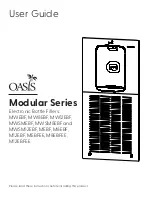
En
gl
is
h (
G
B)
38
7.4 Perform service
Only spare parts and accessories from Grundfos
should be used for maintenance. The usage of
non-original spare parts and accessories renders
any liability for resulting damages null and void.
Further information about carrying out maintenance
can be found in the service kit catalogue on our
homepage. See www.grundfos.com.
7.4.1 Dosing head overview
Fig. 41
Changing the diaphragm and valves
7.4.2 Dismantling the diaphragm and valves
This section refers to fig. 41.
1. Make system pressureless.
2. Empty dosing head before maintenance and
flush it if necessary.
3. Set pump to "Stop" operating state using the
[Start/stop] key.
4. Press the [Start/stop] and [100%] keys at the
same time to put the diaphragm into "out"
position.
– Symbol
must be displayed (see fig. 14).
5. Take suitable steps to ensure that the returning
liquid is safely collected.
6. Dismantle suction, pressure and deaeration
hose.
7. Dismantle valves on suction and discharge
side (5, 6).
8. Remove the cover (9).
9. Loosen screws (8) on the dosing head (7) and
remove with discs.
10. Remove the dosing head (7).
11. Unscrew diaphragm (4) counter-clockwise and
remove with flange (2).
12. Make sure the drain opening (11) is not blocked
or soiled. Clean if necessary.
13. Check the safety diaphragm (1) for wear and
damage. Replace if necessary.
If nothing indicates that dosing liquid has entered the
pump housing, go on as described in section
7.4.3 Reassembling the diaphragm and valves
Otherwise proceed as described in section
7.6.2 Dosing liquid in the pump housing
.
Warning
Risk of chemical burns!
When dosing dangerous media,
observe the corresponding precautions
in the safety data sheets!
Wear protective clothing (gloves and
goggles) when working on the dosing
head, connections or lines!
Do not allow any chemicals to leak
from the pump. Collect and dispose of
all chemicals correctly!
Caution
Before any work to the pump, the pump
must be in the "Stop" operating state
or be disconnected from the power
supply. The system must be
pressureless!
TM
04 1
1
23
21
1
0
1
Safety diaphragm
2
Flange
3
O-ring
4
Diaphragm
5
Valve on discharge side
6
Valve on suction side
7
Dosing head
8
Screws with discs
9
Cover
10
Deaeration valve
11
Drain opening
1
2
3
5
7
8
4
6
10
9
11
Warning
Danger of explosion, if dosing liquid
has entered the pump housing!
If the diaphragm is possibly damaged,
don’t connect the pump to the power
supply! Proceed as described in
section 7.6 Diaphragm breakage!















































